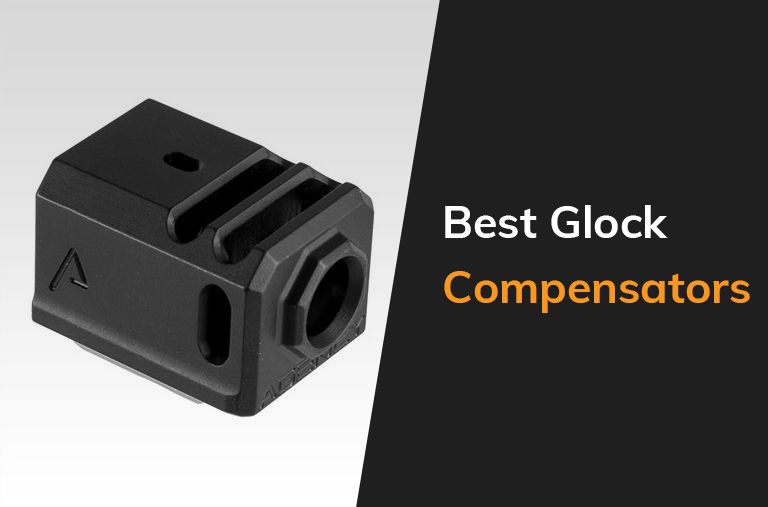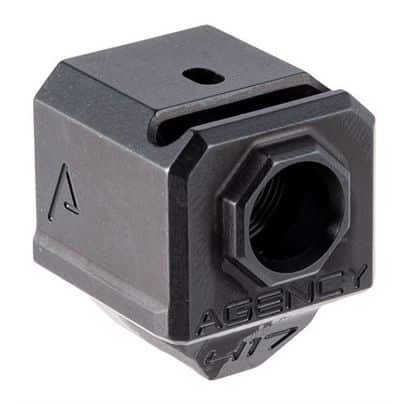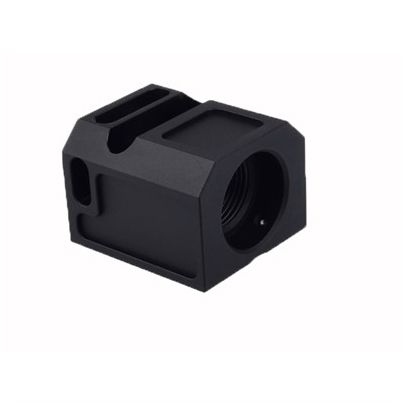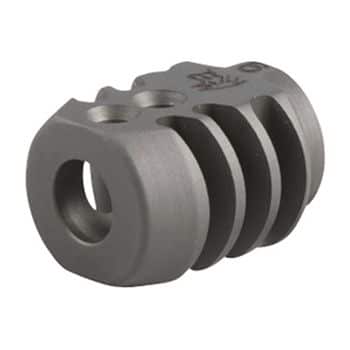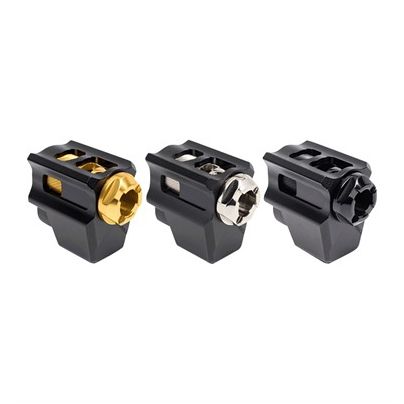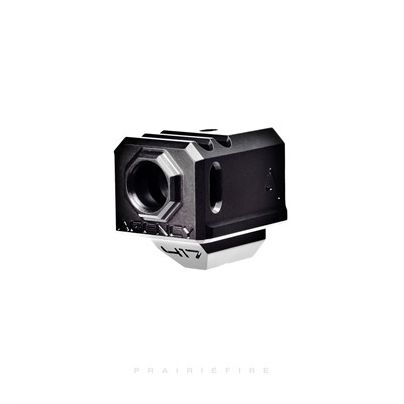At a Glance: Best Glock Compensators
- OUR TOP PICK: Agency Arms 417 Compensator for Glock Gen 3 & 4
- TOP-RATED: ZEV PRO V2 Compensator
- RUNNER UP: CGS Group Qube Compensator
Comparison of The Best Glock Compensators
| PRODUCT | DETAILS | ||
|---|---|---|---|
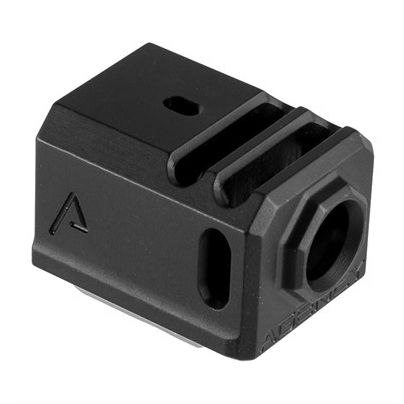
Our Top Pick
|
Agency Arms 417 Compensator for Glock Gen 3 & 4 |
|
View Latest Price |
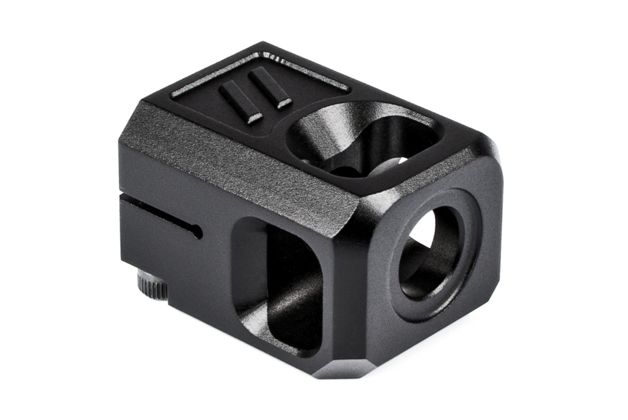
Our Top Pick
|
ZEV PRO V2 Compensator |
|
View Latest Price |
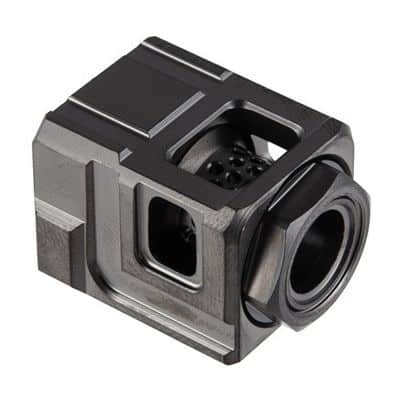
Our Top Pick
|
CGS Group Qube Compensator |
|
View Latest Price |
The pistol earns high marks as a personal defense weapon for many reasons, with small size and concealability topping the list. With a smaller and lighter weapon comes one major drawback: increased recoil. The U.S. Army replaced the venerable 1911 .45 ACP with a Beretta (and ultimately Sig) 9mm because the .45’s recoil was too much for many smaller-framed soldiers. Many shooters choose a weapon in .380 for the same reason. The good news is that there’s no need to trade down to a smaller caliber or lighter load to reduce recoil and thereby improve accuracy and reduce the time needed to get back on target after each shot. The answer is a compensator.
The Glock has earned a reputation as a reliable weapon that’s available in a wide variety of calibers. Thanks to that popularity, plenty of aftermarket accessories are available to upgrade and personalize your weapon—and that includes compensators. With so many options available in the marketplace, some guidance would certainly be helpful, so we’ve evaluated the offerings to bring you a selection of the best Glock compensators.
Our Guide to the 8 Best Glock Compensators
These are our eight leading candidates for the best Glock compensators. We judged them based on design, installation, and impact on reliability. We’ll also explore the length (and weight) they add to the weapon, whether they are removable, and their compatibility with various handguns and barrels. Any impact on handgun accessories (primarily holsters) will also be a factor.
Agency Arms 417 Compensator for Glock Gen 3 & 4
The 417 is designed for Glock 17, 19, and 34 (Gen 3 and 4) models. It uses a dual-chamber design with two vertical and two side venting ports. Although the specs rate it for use with standard factory load ammunition, it actually performs better with hotter loads.
As is typical for Glock compensators, it fits a threaded barrel with a standard 1/2×38 thread pitch. A nice touch is the ability to take the existing front sight and transfer it onto the compensator. The 417s is machined from 7075 aluminum hard anodized to Mil-Spec III.
Note that Agency Arms advises that this compensator is not compatible with conversion barrels, specifically not AlphaWolf, SilencerCo, or Fortis MGF barrels.
Pros
- Less bulky; better for concealed carry
- Accepts existing front sight
- Works well with hotter ammo loads
- Available in black, gold, or gray
Cons
- Incompatible with conversion barrels
- May require tuning of recoil system
ZEV PRO V2 Compensator
The Zev PRO V2 fits Glock 17, 19, and 34 models in 9mm. It features contoured top and side ports. The PRO V2 has a couple of interesting features. First, it uses a mounting system that does not require a thread-locking compound meaning it can be removed and reinstalled while still remaining very secure.
Second, The Zev V2 compensator was designed for the Glock 19, and when combined with ZEV threaded barrels, a G19 with a PRO V2 has the same slide length as a Glock 34 – meaning you can use a G34-compatible holster.
Another nice feature is the set screws. Some compensators have very small Allen screws, and stripping can be a real problem, especially when trying to remove one that has been set with a thread locking compound. The screws on the PRO V2, however, are very robust.
The V2 uses the standard 1/2×28 threading or 13.5×1 left-hand threading. It is machined from aluminum with a Mil Spec III hard anodized finish (black) or Cerakote in burnt bronze or tungsten.
Pros
- No thread locking compound required
- Available in three finishes
- Compatible with G34 holster when mounted on G19
- Enlarged guide rod channel
- Left-hand model available
- Less likely to require recoil spring change
Cons
- May not sit flush on Glock clones
CGS Qube Compensator For Glock
CGS is relatively new to the compensator market, although they made their name with custom rifles and suppressors. They clearly brought all their engineering savvy when they decided to make compensators. The Official Qube’s claim to fame is that it was the first Glock compensator on the market that does not require set screws. This is a definite design advantage since set screws can potentially damage the barrel and/or threads.
While it mounts to a standard 1/2×28 or 13.5x1LH threaded barrel, it uses a combination of tapers and lock nuts to achieve a secure mount.
It is manufactured from 17-4 H900 stainless steel and comes in five color options: black and flat dark earth for more conventional Glock owners and gold, violet, or rainbow if you’re feeling a bit more flamboyant. (Hey, we won’t judge.)
It does add 1.25″ to the pistol’s length, which is fairly standard, so on models with longer slides, you may encounter holster issues. Some light ammo loads (either reloads or light factory 115-grain rounds) can cause cycling issues, although that potential exists with any compensator, and the answer is a lighter recoil spring.
Pros
- No set screws to damage barrel threads
- Removable (no thread locking compound)
- Range of color choices
- Great manufacturer reputation
Cons
- Occasional slide cycle failures with light loads
- May not fit some holsters
Agency Arms 417s Single Port Compensator
Closely related to the 417, the 417s is designed for Glock 17, 19, and 34 Gen 3 models. It differs from the 417 in that it uses a single chamber with a vertical venting port. This produces its primary advantage over the 417: it is smaller and lighter.
It is similarly rated for use with standard factory load ammunition but performs better with hotter loads. As is typical for Glock compensators, it fits a threaded barrel with a standard 1/2×38 thread pitch.
It also enables you to take the existing front sight and transfer it onto the compensator. The 417s is machined from 7075 aluminum hard anodized to Mil Spec III.
Note that Agency Arms advises that this compensator is not compatible with conversion barrels, and specifically not AlphaWolf, SilencerCo, or Fortis MGF barrels.
Pros
- Accepts existing front sight
- Works well with hotter ammo loads
- Available in black, gold, or gray
Cons
- Incompatible with conversion barrels
- May require tuning of recoil system
- No longer manufactured; hard to find
Primary Machine Stealth Comp
Primary Machine’s Stealth compensator will fit any 9mm Glock model except the 43. It fits the standard 1/2×28 barrel threading and while it uses set screws, they are placed on the underside of the compensator to provide a cleaner appearance.
It is manufactured from 7075 T6 billet aluminum. The black version is a standard Mil Spec III hard anodized, but the Stealth is available in 19 (yes, you read that right) different colors ranging from the typical—stainless, Magpul OD green, desert sand, Magpul FDE—to the unique—blue titanium, SOCOM blue, crimson red. There are three different versions of gray alone!
A bit shorter than some compensators, the Stealth adds only 1.2″ to 1.3″ to the weapon’s length, and any open-end Glock holster will accommodate it. (A Glock 19 with a Stealth installed will fit a Glock 43 holster.) Speaking of holsters, the tapered edges on the Stealth help minimize snagging during unholstering—particularly important for concealed carry.
Testing with hand-load ammunition ranging from 90 to 147 grains demonstrated its reliability with various ammunition types.
Pros
- Every color you could want
- Adds less length to weapon
- Works well with variety of ammo loads
- Tapered edges reduce snagging
Cons
- Uses thread locking material, so not easily removable
Lone Wolf Distributors Compensator
True to its name, the Lone Wolf Distributors (LWD) compensator breaks from the pack of Glock compensators. While typical designs are square, to install flush with the pistol’s slide, the LWD is oblong, looking much more like the sort of compensator that would be found on a tactical rifle.
In addition to deflecting gas upward, which counteracts muzzle rise, the LWD also directs gas to the rear at a 30-degree angle. This helps to reduce felt recoil by essentially “pushing” the weapon in the opposite direction.
It fits standard 1/2×28 threaded barrels for Glock 17, 17L, 19, 26, and 34 models in 9mm. However, it does not fit conversion barrels for the 22, 23, 24, 27, or 35.
While its design is excellent for reducing both recoil and muzzle rise, the tradeoff is that the degree of gas diversion means the LWD is less forgiving of lighter-loaded ammunition. The manufacturer warns that 115-grain and other light loads are likely to produce unreliable cycling and further recommend using its proprietary stainless-steel guide rod and a reduced-power recoil spring. These negative effects are more pronounced in tactical or long-slide pistols.
Pros
- Lightweight
- Parkerized steel construction
- Highly effective
Cons
- Compatible with fewer Glock models
- Less reliable with lighter ammo loads
Tyrant Designs T-Comp Compensator
The T-Comp is the best 9mm compensator. it is another design that eliminates the need for set screws or thread locking material, in this case, by using a two-piece design that locks the main body of the compensator against the end of the slide.
The T-Comp’s dual chambers redirect gas upward to counteract muzzle rise but also cools and slow the gases leaving the front of the compensator to reduce recoil. It fits standard 1/2×28 9mm barrels, although Tyrant Designs advises that it is not compatible with most suppressor-length threaded barrels. It is specific to Gen 3 through 5 weapons.
It functions reliably with most ammo loads, although as with any compensator, lighter loads have the potential to cause issues unless you install a lighter recoil spring. There are four color options: black/black, black/gold, black/nickel, or gold/black; the first color is the outer portion of the compensator.
Pros
- No set screws or thread locking material
- Good reliability with most ammo types
Cons
- Limited to Gen3-5 models
- Not compatible with most suppressor-length barrels
Agency Arms 417C Compensator (Glock 43)
Another entry in the Agency Arms lineup, the 417C is designed specifically for the Glock 43. As with other Agency Arms models, the 417C enables you to transfer your front sight from the slide to the compensator.
It is a two-chamber design with two vertical and two side ports. According to its specifications, it is meant to be compatible with the Glock’s OEM recoil spring, but the usual warnings about lighter ammunition loads apply here; if for some reason you want or need to employ these, a different spring may be in order.
It is machined from 7075 aluminum hard anodized to Mil Spec III and available in black, gold, or gray like its brethren. It installs on a standard 1/2×28 threaded barrel using set screws and thread locking material.
Pros
- Accepts existing front sight
- Works well with hotter ammo loads
- Available in black, gold, or gray
Cons
- Set screw/thread locking material installation
What is a Compensator and How Does it Work?
While we don’t want to insult anyone’s intelligence, we also don’t want to make assumptions about what you do and don’t know, especially if you’re new to the firearms world. If that’s the case, and in particular if you’re shopping for your first handgun, we recommend you take a look at our comparison of the best Glocks for beginners.
So before we talk about how compensators work, let’s talk about how the handgun works.
If you’re an old hand at firearms, you can skip the next couple of paragraphs.
All Glocks are semi-automatic pistols. Meaning once you have manually chambered the first round by cycling the slide (that is, pulling it all the way back and allowing the recoil spring to push it forward), the weapon will chamber a new round each time you fire. When the powder inside a cartridge combusts, it creates gas under high pressure. With nowhere else to go, the expanding gas pushes the projectile down the barrel and sends it on its way.
8 Best Glock Barrels For Your Next Upgrade
However, because the bullet fits snugly in the bore of the barrel and resists being shoved out of the way, some of that energy gets transferred to the slide and pushes it backward. As the slide moves back, it ejects the empty casing. It then passes over the magazine, pushing the next round into the chamber where it’s ready to start the cycle again.
Not to dredge up any bad memories of high school physics, but every action has an equal and opposite reaction.
What that means for our pistol is recoil, which is the reaction to the energy used to send that bullet downrange. Some of that recoil was already used to cycle the slide; that’s why semiautomatic pistols kick less than revolvers. Some of it gets used to move the weapon itself, which is why heavier pistols kick a little less than a lighter pistol of the same caliber. The rest of it is the kick you feel, which in addition to pushing the weapon backwards tends to cause the muzzle to rise.
That’s the basics in three paragraphs. (You old hands can rejoin us now.)
What it all means for shooting is that more recoil tends to move your weapon farther off-target each time you fire, so you take longer to get back on target to fire the next round accurately. Not a big deal on the firing range necessarily, but it can literally mean the difference between life and death in a real-world defensive situation. (If you’re getting ready to buy a pistol for self-defense, we can offer some advice on the best Glocks for protection.)
A compensator (so named because it compensates for part of the recoil) functions by redirecting some of the gas that escapes the muzzle after the projectile exits. Virtually every compensator directs some gas upward, countering the muzzle rise. Some also vent gas to the side. This can either reduce the amount of gas going forward and push back on the weapon or, if directed at a backward angle, can help counter recoil by pushing in the opposite direction.
Finally, some designs also give the gas an opportunity to cool somewhat, reducing the amount of energy it carries. Shooters generally report “significant” reduction in recoil. Those who put a number on it will say there is a 40% to 50% reduction in felt recoil. They also report much quicker reacquisition (getting your sights back on target).
How to Choose the Best Glock Compensator
Now that you understand how a compensator works and what it can do for you, the next question is how to choose the best one for you.
There are four areas to consider:
- Installation
- Size and weight
- Design
- And what we refer to as “other accessories,” meaning how the compensator affects weapon accessories like lights, lasers, and holsters.
If you would like to consider what all you might want to add to your Glock as part of choosing a compensator, check out our guide to must-have Glock accessories.
Installation
The most important consideration for compensator installation is that your weapon must have a threaded barrel, something you may have noticed from our overview of the eight competitors.
That said, the most common way to install a compensator is with set screws and a thread locking material like LOCTITE. This method is very reliable and if done correctly almost guarantees that your compensator will not loosen or come off.
The main downside is that it’s more or less permanent. It is possible to remove LOCTITE and other materials like it, but you’ll need to thoroughly clean the threads and set screws after doing so. In other words, the set screw/thread locking method is really meant for a permanent installation on your weapon.
Some manufacturers offer attachment methods that don’t use set screws or thread locking material. These offer a significant advantage in that you can install and remove your compensator at will. The drawback is that the compensator might be more likely to come loose. That isn’t an issue with the compensators we reviewed here, but you should be aware of it if you look at others.
Size and Weight
Pistols are small for a reason: they’re meant to be easily portable and concealable. They also need to fit in a holster. Consequently, you should be particular about how much size you add to your handgun.
All compensators will add length just by virtue of how they function, but that can range from a little over an inch to well over two inches. That can easily make the difference between a weapon fitting in a holster or not, especially for concealed carry holsters that tend to be smaller.
Weight is not as much of a problem; the main concern is that you’re adding it to the muzzle, which is going to change how the weapon handles. If you’re about to learn with a new pistol and install the compensator as soon as you get it, you shouldn’t have any problems. However, if you’re adding a compensator to a pistol you’ve used for a while, you may find that you need to tweak your draw-and-fire technique slightly to account for the added weight.
Most compensators are made from either aluminum or steel. Weight typically ranges from 2 oz. to 2.5 oz. For reference, a Glock 19 9mm weighs 23.63 oz. unloaded and 30.16 oz. loaded, so you’re talking about a roughly 10% increase in unloaded weight and 8% in loaded weight assuming a 2.4 oz. compensator.
Design
There are two main distinctions in compensator design. The first is single chamber vs. dual chamber. The second is the number of ports and their orientation. Single chamber designs typically have a single port, oriented upward. Dual chamber designs will have more ports, usually one top and two sides, although some like the LWD take a slightly different approach. Generally speaking, multiple ports will provide better compensation. The main advantage single chamber/single port compensators have is smaller size and lighter weight, but it’s debatable whether that small difference is worth the tradeoff in performance. The dual chamber/multiple port design is far more common if that tells you anything.
Other Accessories
Here we can only give general advice because there are so many possible combinations of compensators and accessories that we couldn’t begin to assess each one. If you want to add an accessory that occupies the same general area of the weapon, such as a light, you’ll need to do your homework to verify that it will cohabitate and play nicely with your compensator.
In some cases, you may have alternatives. For example, many lasers mount under the barrel, but it’s also possible to get grip-mounted lasers as well. That allows you to install both a compensator and a laser with no worries about whether they’ll work together.
The accessory that’s affected most commonly by a compensator is the holster.
In several cases we pointed out in our compensator reviews models that will fit a Glock 43 holster when attached to a Glock 19. Most open-end holsters will also accept a compensator-equipped pistol with no problem. A simple rule of thumb is the more specific the holster is to a particular model, the less likely it is that it will still work after you install a compensator.
How to Install a Glock Compensator
The installation process varies from model to model. Each one will include instructions and in most cases a handy video on the manufacturer’s website. Generally speaking, you’ll remove the slide from the weapon and the recoil spring from the slide assembly. For models that use set screws, you’ll need to back out the set screws far enough to apply the thread locking material.
(One important caveat: Don’t use too much thread locking material. Apply it with something small like a toothpick. If you put too much and ever need to remove the compensator, you’re just about guaranteed to strip the set screws.)
Next, you’ll ensure the barrel threads are clean and then apply thread locking material. This is the opposite case from the set screws; you’ll want to apply pretty generously. Typically in cases where the compensator loosens, the culprit is not enough locking material on the barrel threads.
Once that’s done, slide the compensator over the muzzle and screw it onto the barrel threads until it makes contact with the slide. Once it does, back it off until it is aligned with the slide and then tighten the set screws. Allow two to three hours for the thread locking material to set.
Again, this is the process for models that use set screws, which is the most common design. The installation will differ significantly for other designs.
Here’s Our Recommendation For The Best Glock Compensator
Before we reveal our selection, it’s important to note that we chose eight high-quality products for this evaluation. Any of them would be a worthy choice for your weapon. Also, in a couple of cases, the deck was stacked against them from the beginning. The Agency Arms 417C, for example, only fits Glock 43s, so it was never going to be a general recommendation to cover a majority of Glock models. (Apologies, 417C.)
We recommend the CGS Group Official Qube. Although the competition was tough, The Qube is a well-designed, high-quality compensator that complements the Glock extremely well. It will reduce felt recoil and significantly improve your target reacquisition time, making you a better shooter and leaving you well-prepared in the event of a self-defense situation.

